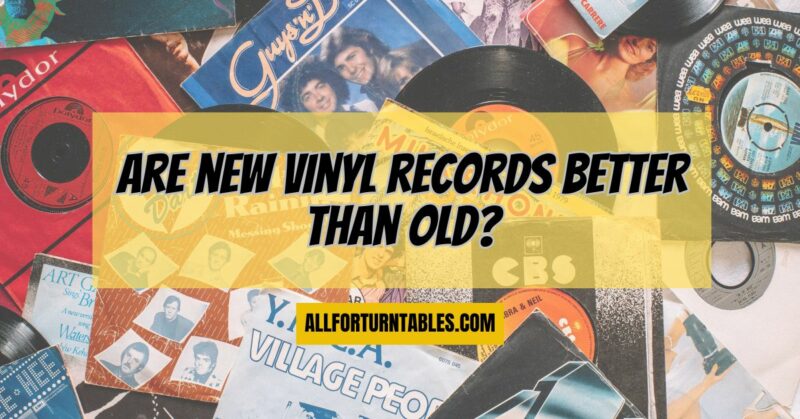Vinyl records have experienced a remarkable resurgence in popularity in recent years. In an age dominated by digital music streaming, the appeal of vinyl goes beyond just the sound. It’s about the tangible, the nostalgic, and the sense of connection to music’s rich history. However, there’s a debate that has been ongoing among vinyl enthusiasts: Are new vinyl records better than old ones? In this article, we will delve into this age-old argument and explore the various aspects that make each generation of vinyl records unique.
The Sound Quality Debate
One of the primary factors influencing the preference for either new or old vinyl records is sound quality. Audiophiles and music enthusiasts often argue that vintage vinyl records have a warm, authentic sound that can’t be replicated by their modern counterparts. This belief is grounded in the analog nature of old vinyl records, which are believed to capture the nuances and imperfections of music in a way that digital formats cannot.
- The Warmth of Analog Sound: Old vinyl records, pressed during the heyday of analog technology, are cherished for their warmth and character. Audiophiles argue that the analog signal path and mastering techniques of the past added a unique sonic depth to these records.
- Vinyl Pressing Techniques: The techniques used in pressing vinyl records have evolved over time. Modern records often use different materials and manufacturing processes, which some argue can lead to a cleaner sound but may lack the warmth associated with vintage records.
- Mastering Differences: The way music was mastered for vinyl in the past was tailored to the format’s limitations and unique characteristics. This can result in a sound that is distinct from digital audio or modern vinyl pressings.
Durability and Longevity
Another aspect to consider when comparing old and new vinyl records is their durability and longevity. Vinyl records, regardless of age, are susceptible to wear and tear, but some argue that older records, if well-maintained, can outlast their newer counterparts.
- Vinyl Quality: The quality of vinyl used in older records may vary, but some claim that older vinyl was more robust and less prone to warping or degradation over time.
- Storage Conditions: Proper storage is essential for preserving vinyl records. Some collectors believe that older records have had more time to accumulate proper storage conditions, while newer records might not have received the same care.
- Collector’s Value: Older vinyl records often hold collector’s value, which incentivizes owners to take better care of them. This can contribute to the longevity of vintage records.
Availability and Rarity
The availability of vinyl records, both old and new, can be a significant factor in the debate. Some records, especially older ones, are considered rare and highly sought after by collectors. New vinyl records, on the other hand, may offer a broader range of contemporary music but lack the historical significance of their older counterparts.
- Collectibility: Vintage vinyl records can be considered valuable collector’s items, particularly if they are rare or from a specific era or artist. This collectible aspect can add to their appeal.
- Selection of Music: New vinyl records allow music lovers to access contemporary music, including recent releases and emerging artists. The variety of music available in new vinyl format is undoubtedly a selling point.
- Resurgence of Old Classics: Many classic albums from the past have been reissued on new vinyl. This gives listeners the opportunity to enjoy beloved music with improved sound quality and modern pressings.
Cover Art and Aesthetics
Vinyl records are not only about the music but also the visual and tactile experience. The cover art, packaging, and overall aesthetics play a significant role in the vinyl experience, and this can vary between old and new records.
- Nostalgia: The cover art and packaging of older vinyl records often evoke a sense of nostalgia, taking listeners back to the era in which the music was originally released.
- Modern Design: New vinyl records sometimes feature updated or modernized cover art and packaging. This can be appealing to those looking for a fresh take on classic albums or a contemporary aesthetic.
Conclusion
The debate over whether new vinyl records are better than old ones ultimately comes down to personal preference. Audiophiles may prefer the warm, analog sound of vintage records, while others may appreciate the convenience and accessibility of new vinyl. Additionally, collectors may seek out rare vintage records for their historical significance, while music enthusiasts may be more interested in the latest releases available on vinyl.
Ultimately, the beauty of vinyl records lies in their diversity and ability to cater to a wide range of tastes and preferences. Whether you’re a seasoned collector or a newcomer to the vinyl scene, both old and new records offer a unique and valuable listening experience that continues to captivate music lovers around the world. So, the next time you’re deciding between a vintage gem and a fresh release, remember that the choice is yours, and both have something special to offer in the world of vinyl.


